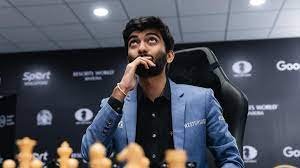The atmosphere at the Freestyle Chess Grand Slam event is one unlike any other. The regular chess tournament routine has been thrown out the window, replaced with a combination of unexpected twists, technological advancements, and vibrant visuals. Indian World Champion D Gukesh, known for his sharp mind and deep knowledge of traditional chess, will soon experience the intense pressure of freestyle chess, where strategy becomes more about adaptation and less about memorization. In this event, positions on the back ranks are randomized, and players only get to see the starting position of the board a mere 15 minutes before each match begins. This adds a layer of unpredictability to the game, one that even top grandmasters like Magnus Carlsen and Hikaru Nakamura are not immune to.
As Carlsen prepares for his match, a different energy fills the room. In a usual setting, grandmasters like him retreat into their personal bubbles, focusing solely on the board in front of them. Silence prevails, and there is a palpable air of seriousness, even in the moments leading up to the game. Not today, however. A camera technician approaches Carlsen, who is deeply engrossed in his thoughts. He seems unperturbed by the intrusion, his eyes glued to the board as the technician starts mic-ing him up. The presence of a camera crew so close to the action, especially minutes before the game begins, would normally disrupt the concentration of any top player. But Carlsen is ready, offering no resistance. His focus remains unbroken as the technician slips wires under his jacket.
This scene marks the distinct nature of the Freestyle Chess Grand Slam, where the event’s format and flair go beyond the mere technicalities of the game. The tournament is characterized by an interplay of chess and entertainment, merging traditional strategies with modern-day spectacle. While chess is deeply rooted in discipline and concentration, the Freestyle Chess Grand Slam has brought a more relaxed, almost cinematic atmosphere to the playing hall. Chess players, especially those competing at the highest levels, have often been known for their stern and solitary nature, but this event encourages a blend of creativity, unpredictability, and engagement with the audience.
The event is also marked by its fashion-forward approach. Gone are the usual formalities of suits and ties. Instead, players sport brightly colored jackets, adding a sense of vibrancy to the proceedings. The colorful attire reflects the break from convention, as well as the event’s aim to make chess more accessible and visually engaging for viewers. This is chess as it has never been seen before—a blend of intellect, strategy, and modern-day entertainment.
As the match begins, the excitement in the air is palpable. The randomness of the starting position requires the players to adapt quickly. Their strategic mindset, honed over years of practice, must now adjust to the altered rules of freestyle chess. They no longer have the luxury of relying on familiar opening moves or pre-planned strategies. Each game is a new challenge, one that tests a player’s ability to think on their feet and adjust their tactics with little to no preparation.
Gukesh, with his incredible rise in the chess world, will undoubtedly bring his own flair to the event. The young Indian grandmaster has shown time and again that he is capable of handling the pressure of elite chess tournaments. As he steps into the Freestyle Chess Grand Slam, he will experience firsthand the challenges posed by the event’s unpredictable nature. The pressure to perform, knowing that the game could take an unexpected turn at any moment, will certainly test his mental strength and adaptability.
The Freestyle Chess Grand Slam is more than just a series of matches. It is a celebration of the game, its players, and its evolution into something more than a traditional sport. It blends the intellectual rigor of chess with the excitement and spectacle of modern-day entertainment. As the players engage in these fast-paced, random-positioned matches, they not only demonstrate their prowess but also contribute to the changing face of chess—a game that is constantly evolving, both in terms of strategy and the way it is perceived by the public. This unique approach promises to revolutionize how the world experiences and celebrates chess, attracting new audiences and pushing the boundaries of the game into uncharted territory.
The energy around the Freestyle Chess Grand Slam is unlike any other tournament. The fans who have grown accustomed to the traditional, intense silence that typically surrounds the game now find themselves immersed in an entirely new atmosphere. The event organizers understand that modern audiences crave more than just the strategy of the game. They want an experience that is as visually captivating as it is intellectually stimulating. As a result, they have introduced cutting-edge technology and theatrical elements that elevate the entire experience, making it as engaging for casual viewers as it is for seasoned chess aficionados.
Interactive features play a large role in the event’s success. With advanced streaming technologies, viewers at home can get a close-up view of every move, allowing them to feel like they are part of the action. As the game progresses, there are constant updates on player strategies, highlighting the decisions made by the grandmasters and explaining the reasoning behind each move. This level of transparency makes the game more accessible to the average viewer, breaking down the complexities of chess and giving fans an opportunity to understand the nuances that make these top players so skilled.
While the game may be unpredictable, one thing remains constant: the level of preparation needed to succeed at this event is unmatched. Grandmasters like Carlsen and Nakamura have spent their entire careers building a strategic mindset that can handle anything thrown their way. Yet, even they are challenged by the freestyle format. In a way, this forces them to tap into a new mental reservoir—a place where adaptability and innovation become just as important as raw calculation and deep knowledge of traditional chess patterns.
For players like Gukesh, who are still relatively new to the global chess scene, the stakes at the Freestyle Chess Grand Slam are high. However, this is also an opportunity for them to prove their versatility. Gukesh’s participation signifies that the younger generation of chess players is ready to embrace the challenges that come with the freestyle format, demonstrating that adaptability is now a core skill in the modern chess world. His growth in the chess community has been remarkable, and many are excited to see how he performs when faced with such a high-stakes, unpredictable format.
Despite the entertainment-heavy atmosphere, the core of the event remains unchanged: it’s still about the game of chess, where strategy and intelligence reign supreme. However, the organizers have successfully created an environment where the lines between sport and entertainment blur, giving players the freedom to showcase not just their skills but also their personalities. Whether it’s through their colorful jackets, their interactions with the crew, or their ability to stay focused in such an unorthodox setting, the players become more than just competitors—they become stars.
As the Freestyle Chess Grand Slam continues to grow in prominence, it may very well redefine the future of competitive chess. The potential to attract a wider audience, especially those who may have found traditional chess too slow or opaque, is immense. The excitement and unpredictability of the format, combined with the engaging presentation, could open up new avenues for the game. It is not just about proving who is the best player anymore—it’s about creating an experience that is as thrilling to watch as it is to play.
Ultimately, the Freestyle Chess Grand Slam serves as a testament to chess’s evolution. It showcases the game’s ability to adapt and grow, maintaining its intellectual rigor while simultaneously embracing new ways to captivate and entertain audiences. As more players like Carlsen, Nakamura, and Gukesh push the boundaries of what is possible in chess, the future of the game seems more exciting than ever. The unpredictable nature of freestyle chess, paired with the unique atmosphere of the Grand Slam, is bound to leave an indelible mark on the chess world for years to come.



